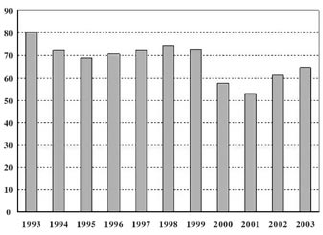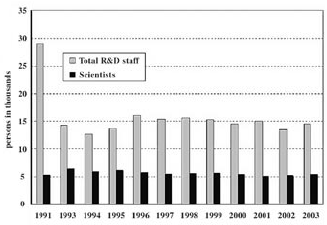Lost financing from the USSR government and business structures caused considerable changes in the R&D structure during the first years of the re-gained independence. Large USSR military based research institutes collapsed. Large number of research laboratories at the industrial enterprises and various designing-engineering institutions were closed. Experimental development divisions at the higher education establishments and research institutes were reduced to the minimum or totally eliminated.
In the beginning of the reorganization of the Lithuanian economy, the state budget remained the major source of R&D funding. In 1993, funds of contracting authorities and other non-budgetary funds made up only 20 % of the gross expenditure on R&D (Fig. 1). As part of the R&D contracting authorities also controlled the state budget funds, statistical indicator ”the funds of the contracting authorities” also included the state budget allocations. Therefore, the part of the state budget allocations, particularly in the early years, in reality was larger.

Figure 1. The part of state budget funds in the gross expenditure on R&D (percentage).
Circumstances mentioned above inevitably influenced the number of R&D staff (Fig. 2). During three years (1990–1993), the total R&D staff reduced more than twice. The number of researchers reduced analogically. The number of scientists (researchers having PhD or a higher research degree) was the only to remain almost the same. Therefore, a significant change in the staff structure occurred: the part of researchers having no research degree considerably reduced. After 1993 the number of the total R&D staff, as well as the number of researchers, including scientists, changed insignificantly, however, the tendency to reduce remained.

Figure 2. R&D staff and scientists, in total, working at the main working place.
The Law on Research and Higher Education adopted in 1991 changed the status of the Lithuanian Academy of Sciences. The Academy was not a ”ministry of science” anymore. It lost its research institutes as well. At the same time a unique experiment was launched in Lithuania: 29 research institutes were temporally granted a status of the state research institute. This status has almost equalled the autonomy of the institutes to the autonomy of higher education establishments.
The experiment showed that a high level of autonomy enabled strong research teams to raise considerably the research level and to integrate into the world research community. Some of former sectorial research institutes made particulary great progress in improving the research level. In this context, the following institutes are worth mentioning: the Lithuanian Institute of Horticulture and the Lithuanian Institute of Agriculture. However, for weak institutions, the autonomy became the means to protect themselves from external impact and to maintain the current situation.
PAfter 1990, all R&D entities met a necessity to change the orientation in R&D: to terminate insignificant, non-urgent R&D activities, and to orient themselves towards the Lithuanian needs. As the international contacts became more intense, the valuation criteria of R&D activities started changing: the importance of activity indicators adopted on the international level has been increased. Competition in the free market became a totally new phenomenon in the area of the experimental development. As in other post-communist countries, the situation was complicated by the fact that industrial enterprises had to choose the technologies of world-known companies rather than of local researchers.